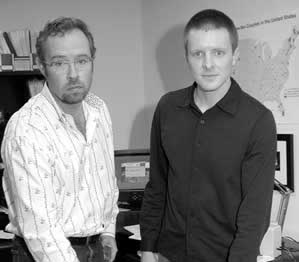-
- Same-sex marriage moves to top of election topics
- Domestic partner benefits involved in Proposal 2 debate
- Ohio Supreme Court rejects legal challenge to same-sex marriage
- Census snapshot of gay and lesbian service members and vets
- Schools should be kept out of same-sex marriage debate
- Mayor’s appointee resigns over New York domestic partner policy
- National News Briefs
- World News Briefs
national
Census snapshot of gay and lesbian service members and vets
Report estimates 36,000 gays and lesbians on active duty
Published Thursday, 28-Oct-2004 in issue 879
An analysis of data on same-sex couples from the 2000 Census has produced the first ever estimates of the numbers of gays and lesbians who are serving or who have served in the military. Perhaps most surprising are the differences between men and women.
The report, “Gay Men and Lesbians in the U.S. Military: estimates from the Census 2000,” was written by Gary Gates, a researcher at the Urban Institute and co-author author of the Gay and Lesbian Atlas released on Oct. 20.
The report estimates that 36,000 gay men and lesbians are serving on active duty, or 2.5 percent of the total active-duty military. Including those serving in the National Guard and Reserves boosts that total to 65,000, or 2.8 percent of all military personnel.
Gay men are underrepresented among active-duty personnel, at only 1.4 percent of the total, while lesbians are greatly over represented at 9.3 percent. Many surveys have found that gays and lesbians constitute roughly 5 percent of the population, with a ratio of about 2 to 1 male to female.
Other striking findings are that lesbians are on average four years older than their gay male counterparts and are more likely to be white than African American. This suggests to Gates that many minorities are using the military as a way out and to access benefits such as education, while for white lesbians with greater economic options, it is more of a career choice. “Especially given that it is the opposite for men,” he said.
“The important [thing to] take away is that there is a non-trivial portion of women in the military that are lesbian. The other story is, given the kind of invisibility of ‘Don’t Ask, Don’t Tell,’ you can show for the first time that gay and lesbian people have been serving in the military for as long as we have had a military. Up until this time we have not had the data to prove that.”
Gates said, “To the extent that ‘Don’t Ask, Don’t Tell’ was a political compromise between a group that essentially didn’t want gay people to serve and a group that did; there is evidence to substantiate that both groups have had some success with that policy.”
There also is evidence that “the policy still filters gay men out, but their service rates are starting to get more similar over time. It suggests that ‘Don’t Ask, Don’t Tell’ has made it a bit easier for gay men to serve. The problem with that analysis is that it doesn’t fit for women.”
Gates acknowledged a possible alternative explanation for the shifts, “It could say something about society changing and being more accepting, and gay people feeling they can make these choices” to either stay in the military, form coupled relationships, or report them on a census form.
The analysis drew upon self-reporting of same-sex couples in the census data, the same pool of data that was culled for a recently released study on black same-sex couples. Most experts use this as the best census marker of gays and lesbians.
“An interesting aspect of this is that we derive the estimates having never asked anybody in the censuses whether they are gay or lesbian,” Gates said. The question can be even more complicated with young people in their late teens and early 20s who may not yet have a clear sense of their sexual identity and are much less likely to be in a coupled relationship. That population constitutes the greatest portion of those in uniform.
Gates acknowledged that “it is a difficult and challenging question” to try and figure out how representative same-sex couples are of the gay and lesbian community overall. “The short answer is, it depends on the characteristic you’re looking at.” On the simple question of geography, they appear to be similar. “Where you find a lot of gay couples, you’re likely to find a lot of gay people in general,” he said.
“But one characteristic they likely do differ on is military service rates. It is likely that single gay people are quite a bit more likely than their coupled counterparts to report military service because under a policy where you are obliged to secrecy, having a partner makes that much more difficult.
“In general, the coupled sample is going to be skewed a little older than the broad gay and lesbian population; you would expect that. But, truth be told, we don’t know that for certain; we don’t have a simple way to assess the differences between coupled and single gay people.”
C. Dixon Osburn, executive director of the Servicemembers Legal Defense Network, called the report an important one because it documents that, “The number of lesbians and gays in service today is equal to half the total force strength currently serving in Iraq and is more than twice the 30,000 additional troops the Army chief of staff says he needs to fight the war on terrorism.”
“There is no doubt that America needs her lesbian and gay patriots fighting on the front lines… they should be able to do so openly,” he added.
More than 10,000 members of the armed forces have been discharged under “Don’t Ask, Don’t Tell” since its passage in 1993.
|
|
Copyright © 2003-2025 Uptown Publications


